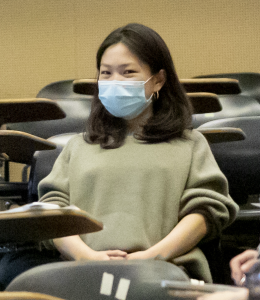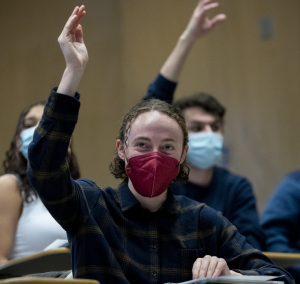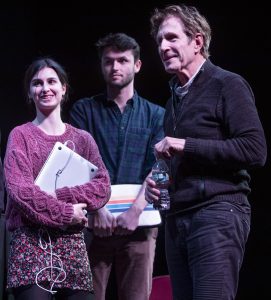By Perla Figuereo (BFF 2019; Bates Class of 2021)
I like to think of myself as a person who pushes for diversity in everything I do. I like to believe that I think about intersectionality at all times because I am a person whose identity needs to be addressed and accepted as one that is intersectional. But, like all reality checks in life, I was proved wrong. During the planning of the 2019 Bates Film Festival, my idea and view of diversity and inclusion were challenged and shifted.
Ever since I started becoming interested in the film industry and entertainment, I loved to find films that told stories like mine, which weren’t many. I wanted to be represented so badly because I was not used to seeing myself represented. But, due to the lack of representation and my access to film, I did not get much of that.
“I wanted to be represented so badly because I was not used to seeing myself represented.”
Nowadays with empowerment movements such as Netflix’s “Strong Black Leads,” there is this new want and push for diversification and for underrepresented stories to want to be told. It has been astonishing to see how in the last few years we have TV Shows like Orange Is the New Black, Pose, Black-ish, Insecure, Grown-ish, How to Get Away with Murder, Atlanta, Power, and so many others tell such unique narratives. There is an explosion in production and screenwriting for stories to be told. And why is this? Because someone realized these stories are the stories that need to be heard.
In my opinion, the entertainment world was ready for new things. But this raises the question of who can tell these stories. This is a question that started to come to me as we were watching the films that we were considering for the festival. Since the festival’s mission is to promote films that center around social justice and those films that provoke conversation, I was so caught up in just having films that had diverse casts and ones that talked about relevant issues. What I was not thinking about was who is making these films?
During this course, the question of what we are programming centered our conversations, but also the question of who we are programming. Automatically, my focus went to picking films whose characters were diverse, whose stories were unique, and stories that met the mission statement. These I thought were great things to look out for because they promoted diversity. But something that challenged my idea of what was “diverse” was thinking about who is making these films. A lot of the films that we got to see and the ones we ultimately programmed were stories of certain groups of people and told by ones that did not identify as the same race, ethnicity, or nationality. For example, a story could be about a Latinx individual, but be directed by a white identifying person. So, the question is, how many layers of diversity do we look for when programming? We kept thinking and discussing all these films, but when it came down to who made them, a lot of the directors were white telling stories about non-white individuals.
For me, this was a hard concept to think about because there are so many elements and people that are involved in the production of a film. This means that when you start thinking about diversity, especially for a festival grounded in social justice, the approach needs to be very intersectional and holistic. It was a big discussion when we were trying to have an array of films that touched on so many issues, but then when we looked at the people who directed the films, we noticed that it was very white-male-centric.

I produced a panel event called “Representing Difference,” which included panelist Professor Charles Nero (Rhetoric, Film, and Screen Studies, Africana Department), Sarah Rose Huckman (Changing the Game), Carmine Pierre-Dufour and Emilie Mannering (co-directors of Mahalia Melts the Rain), and Professor Erin Murphy (filmmaker and Colby College Cinema Studies). A recurring topic that came up during this panel that has been on my mind every day following was this idea of “diversity at all costs.” There were a lot of different ideas and concepts that were brought up by the panelists that got me to think about this topic of diversity and storytelling. One thought that was brought up in the panel was how at the end of the day representation is a representation and even if there is a white director or just anyone different from the group that they are telling a story about, that is still an opportunity for those who are not usually represented to be viewed on-screen. I started to think about how as long as there is good intent in their hearts when making the film and not just doing work that will bring them money, then anyone can tell a story that is different from theirs. It has to come from respect and the goal of spreading love and knowledge.
“If there was anything I learned during the planning portion and during the actual festival, it is that organizing a festival comes with personal battles and a push to look beyond what you consider diverse in your mind. “
I kept finding myself in this battle between choosing films that I considered well-done and films that were told by either people of color or women. I felt like I needed to support underrepresented groups but also kept thinking about the quality of films that we wanted to show to make sure our audiences were not only moved by our films but also to build trust that we will bring great films in future festivals. This was a battle that I had never experienced before because I did not think about how layered the topic of diversity could be in the film world.
If there was anything I learned during the planning portion and during the actual festival, it is that organizing a festival comes with personal battles and a push to look beyond what you consider diverse in your mind. During those two months, I was challenged to reconsider how I thought about issues of diversity. This planning process showed how complex and multilayered it is to really think about such an issue. I thank the process for allowing me to reevaluate my own perspectives and showing me that the work for diversity and inclusion is a process that I need to consistently keep reevaluating and adjusting when I notice that there is another intersection in the topic that needs to be addressed at the moment.
These things were hard. I did not think that choosing films would provide me with such a big reality check on how we value diversity on screens. There are still other aspects of diversity that need to be looked at.






